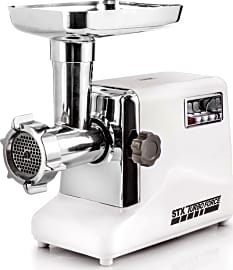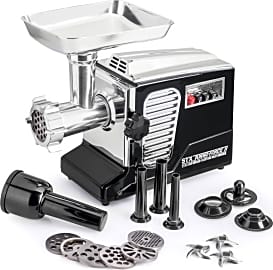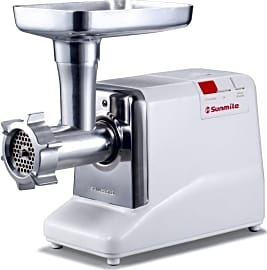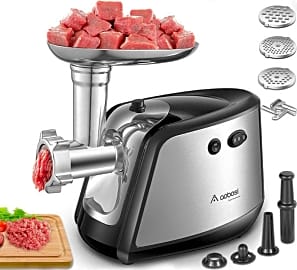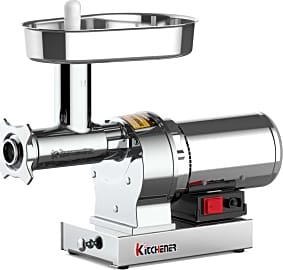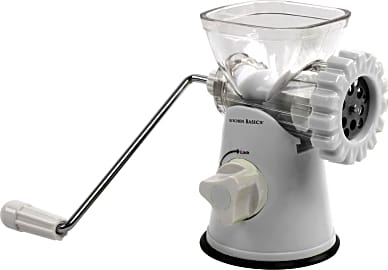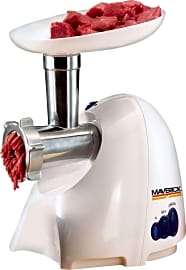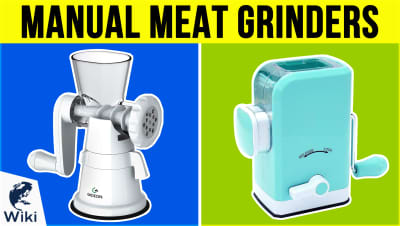The 10 Best Meat Grinders

This wiki has been updated 47 times since it was first published in February of 2015. Freshly ground meat results in the tastiest hamburgers, bolognese, and sausages. Our selection of meat grinders includes manual and electric versions suitable for either the occasional grillmaster or a professional establishment in need of a heavy-duty option. Many are versatile enough to also mince fruits and veggies for making baby food, and some can even create homemade pasta, too. When users buy our independently chosen editorial selections, we may earn commissions to help fund the Wiki.
Editor's Notes
November 01, 2020:
In this update we removed the Sunmile SM-G73 and the Gorumia 525 due to availability concerns. We added the Kenome Attachment for its widespread popularity and extensive compatibility with many of the more common household stand mixers. We also added the Aobosi 3-in-1 because its efficacy as a normal grinder is complemented by its additional value as kubbe maker.
December 05, 2019:
Fresh-ground meat makes a significantly tastier burger than store-bought hamburger meat. If you don't plan on making huge batches of meat, you can probably get by with a hand-cranked model such as the Kitchen Basics 3-in-1, which also doubles as a pasta maker and vegetable grinder. If you don't see yourself using it frequently but don't want to put in the extra elbow grease, a basic electric model like the Gorumia 525 might suffice; for a bit more power look to the Maverick Mince Master or Sunmile SM-G73. All three of these will do a good job with the right cuts, although you'll have to make sure to start by slicing the meat small enough to fit, especially if there's a lot of connective tissue involved.
The Kitchener Heavy-Duty and Sunmile SM-G50 are a step above those entry-level options and their maximum capacity as well as duty cycle is notably greater, although they still won't suffice for full-time use. If you tend to process a variety of meats, for example various parts of a deer, the STX Turboforce Classic and STX Turboforce II are definitely worth a look. They're been popular for years and come with a relatively comprehensive set of attachments and accessories to help get the most out of them. And if you know you'll be putting your grinder through the wringer, the Kitchener Elite and Lem Products Big Bite might be for you. They're both available in a number of sizes maxing out at the reasonably large #32, and while pretty expensive, they're certain to get the job done right, every time, for hours of use at once.
Of course, to do it right, you'll also need a good knife to get the raw meat cut to size and a quality butcher block on which to do that.
Special Honors
Avantco Equipment They only have a couple and they may not look like much, but they're well-ventilated and durable enough for a full-time duty cycle. They are, of course, a bit more costly than those designed for home use, but as long as you're not running a restaurant based exclusively on burgers, they'll do a fine job. avantcoequipment.com
Vollrath Foodservice Vollrath is quite well known for their huge variety of kitchen appliances, and their meat grinders are every bit as reliable as the rest of it. They offer #12 and #22 sizes and you can rest assured that, with proper upkeep, they'll work well for years to come. vollrath.com
Hobart Culinary If your professional institution is in need of a high-capacity machine that can power through hundreds of pounds of meat per day without blinking an eye, you need a Hobart. There's basically no limit to what some of their machines can do. As you might expect, however, such commercial-grade quality is exceptionally expensive -- and they're also pretty loud. Always wearing eye and hearing protection with appliances this loud and powerful. hobartcorp.com
Meat Your Maker
You can also use your unit for exotic meats, fish, or vegetables.
The primary function of a meat grinder, also known as a meat mincer, is, as the name suggests, to grind meat. While some consumers might view the practice as a superfluous task, there are many benefits to grinding your own product in the domestic setting of your kitchen.
Contrary to what you might believe, your local grocery store most likely does not grind their own meat. It is preground in a factory, and then shipped to your location, where is sits for several days to a week, all the while losing its flavor and freshness. You don't know the conditions in which the meat is processed at a factory, which can be unsettling for some. So by purchasing meat and grinding in at home, you can rest assured knowing that your kitchen is sanitary, and that you're at a lower risk foodborne illness.
Grinding your own meat is also cost-effective. At a local grocer, a ground roast will be more expensive than its whole counterpart. As a consumer, you are paying a premium for someone to run the product through the grinder. It may be better to grind it yourself and experience some of the savings.
Many others opt for the DIY meat grinding solution due to the flexibility and customization it offers. You can add whatever you want to the machine. Perhaps you want to ensure that only grass-fed beef goes through your grinder, or healthier meat with less fat content. Customizing your roast with spices is fair game, if you'll pardon the pun. You can also use your unit for exotic meats, fish, or vegetables. Or, you may chose to include additives to increase the shelf life of the meat.
Meat grinders can also be used for the casing of sausages, including vegetarian sausages. You can encase veggie-friendly options that give the appearance of a meat sausage, and do it for a fraction of the cost offered at supermarkets.
To grind or Not to Grind
The grinder is a simple machine with only a few essential parts: the motor, auger, blade, and plate. The motor size will have the largest effect on the expediency of your grinding. Smaller models have difficulty grinding large chunks of meat, as you must pare down the chunks before you add them to the unit. This is time consuming and seems to defeat the purpose of a grinder. A larger machine, however, will allow you to process larger quantities with greater ease. This is also comes into play when grinding bone or gamey meats like venison.
If you do not own a mixer and intend to purchase a stand alone unit, however, our list has compiled the best.
Albeit more rare, manually-operated models still exist, where your muscle power replaces the motor through the use of a hand crank. With those units, you control the speed of the machine and are not limited by electric power. This may not be the best option when doing high volumes of grinding, of course, as your arm will tire and you may not work at a consistent pace, resulting in a less even grind.
The grinder consists of a corkscrew-like device that pushes the meat forward to be chopped by the blade. This is called the auger, or the worm. Most are standard with the machine, though you should make sure that it is easily dissembled from the grinder for regular cleaning.
The blade and plate work together to cut the meat and push it through. The former simply cuts the meat into a manageable size to pass through the latter, which breaks it down into long, soft pieces. The size of those pieces is determined by the plate's holes, which can vary in width. Models that include different sizes of plate holes allow you to chose how large you'd like the grind to be.
A grinder attachment can also be added to existing kitchen appliances, such as a stand mixer. Kitchenaid, for example, famously boasts that any of their brand's grinders will fit on Kitchenaid mixers. If you do not own a mixer and intend to purchase a stand alone unit, however, our list has compiled the best.
A Brief History of the Meat Grinder
The meat grinder replaced the manually-operated mincing knife, which performed the same function with more effort. While mincing knives are still being produced today, they cannot hold a candle to the ease and consistency of an electric meat grinder.
The uses of the grinder have become more sophisticated, too: they are now capable of grinding cheeses, vegetables, nuts, and other foodstuffs.
German inventor Karl Drais conceived the first ever meat grinder in the nineteenth century. The model was operated with a hand crank, and meat was forced through a thin metal plate, resulting in long strands of ground meat. With the advent of new technology, however, electric models have begun rising to prominence in the past century.
Current units can grind several pounds of meat at a time, all with excellent consistency. The uses of the grinder have become more sophisticated, too: they are now capable of grinding cheeses, vegetables, nuts, and other foodstuffs. They case sausages with a simple attachment, and they can make pasta and other culinary creations.
As more and more consumers become health conscious, the demand for meat grinders has increased. The recent backlash against GMO foods especially has many people turning to their own means of meal preparation. Join the movement and you too can create gourmet, fresh meat with one of these units.


